2. Mapping and creation of individual development plan
Mapping and creation of IDP (individual development plan)
Description:
This module provides a structured framework to assess the individual situations of unaccompanied refugee minors and support them in setting and achieving personal development goals through tailored intervention plans.
It is underpinned by youth work and social work principles, integrating prevention, intervention, and holistic care. Interventions are person-centered, culturally sensitive, grounded in user involvement, and tailored to each young person’s unique background and aspirations.
The module acknowledges the complex interplay of individual, relational, community, and societal factors that place minors at risk, requiring action across multiple levels of support at the same time.
Aim:
To ensure unaccompanied refugee minors are safely supported, empowered, and equipped to achieve their full potential through comprehensive assessment and the creation of personalized development plans.
Learning outcomes:
Participants engaging with this module will:
- Develop the capacity to carry out holistic, ecological assessments.
- Design and implement Individual Development Plans aligned with each minor’s aspirations and circumstances.
- Understand and apply youth work and social work principles in practice.
- Facilitate personal development, integration, and independence among unaccompanied minors.
Applying Youth Work and Social Work Principles in Practice
Introduction
Effective practice with young people and communities requires a deep understanding of the core principles that underpin both youth work and social work. While each discipline has distinct roles, they share common values centred on empowerment, rights, and social inclusion.
A structured framework is essential to assess the individual situations of unaccompanied refugee minors and to support them in setting and achieving personal development goals through tailored intervention plans.
This framework is underpinned by the principles of youth work and social work, integrating prevention, intervention, and holistic care. Interventions are:
- Person-centred, ensuring that each young person’s needs, strengths, and aspirations guide the process;
- Culturally sensitive, recognising and respecting diverse backgrounds and experiences;
- Grounded in user involvement, promoting active participation and ownership of decisions;
- Tailored to each young person’s unique circumstances, fostering meaningful and relevant support.
This approach acknowledges the complex interplay of individual, relational, community, and societal factors that place minors at risk. Consequently, it requires coordinated action across multiple levels of support simultaneously to effectively respond to these challenges and promote positive outcomes.
Core Principles of Youth Work
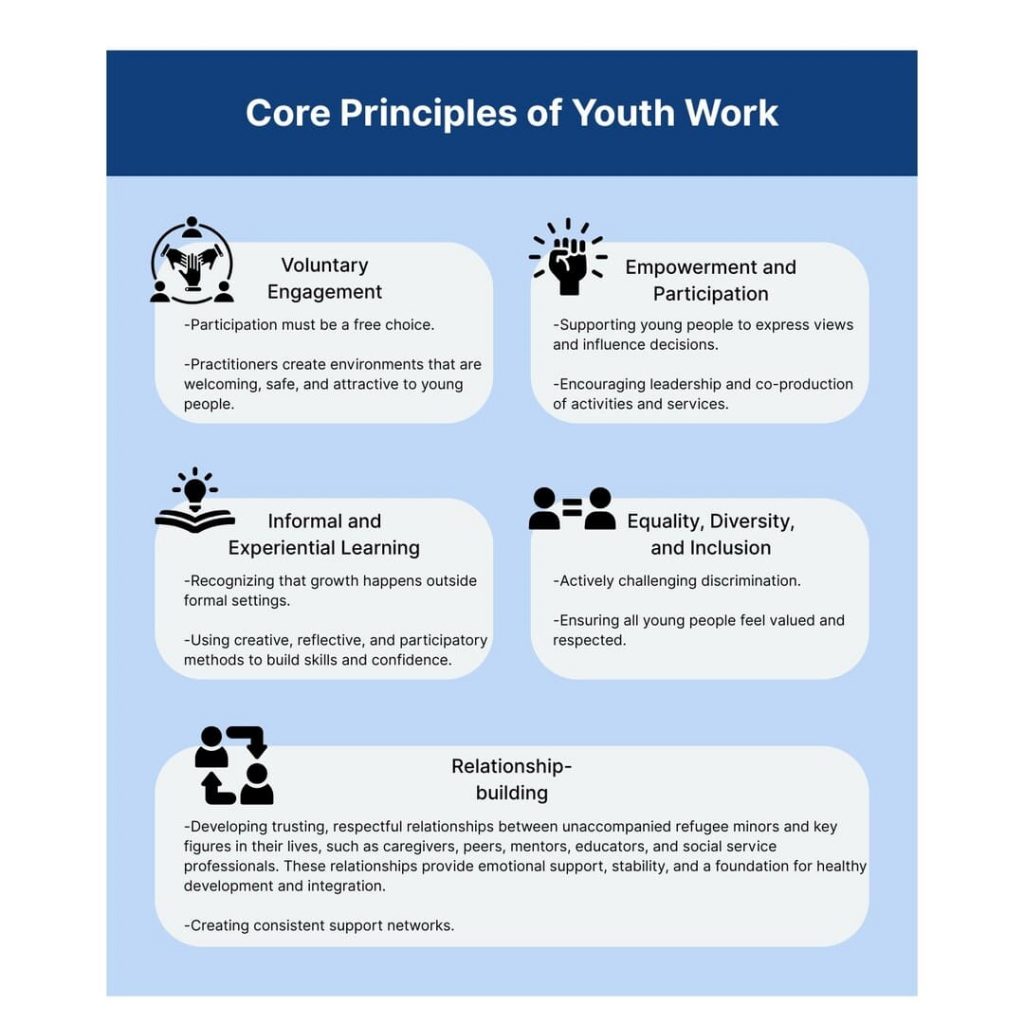
Core Principles of Social Work
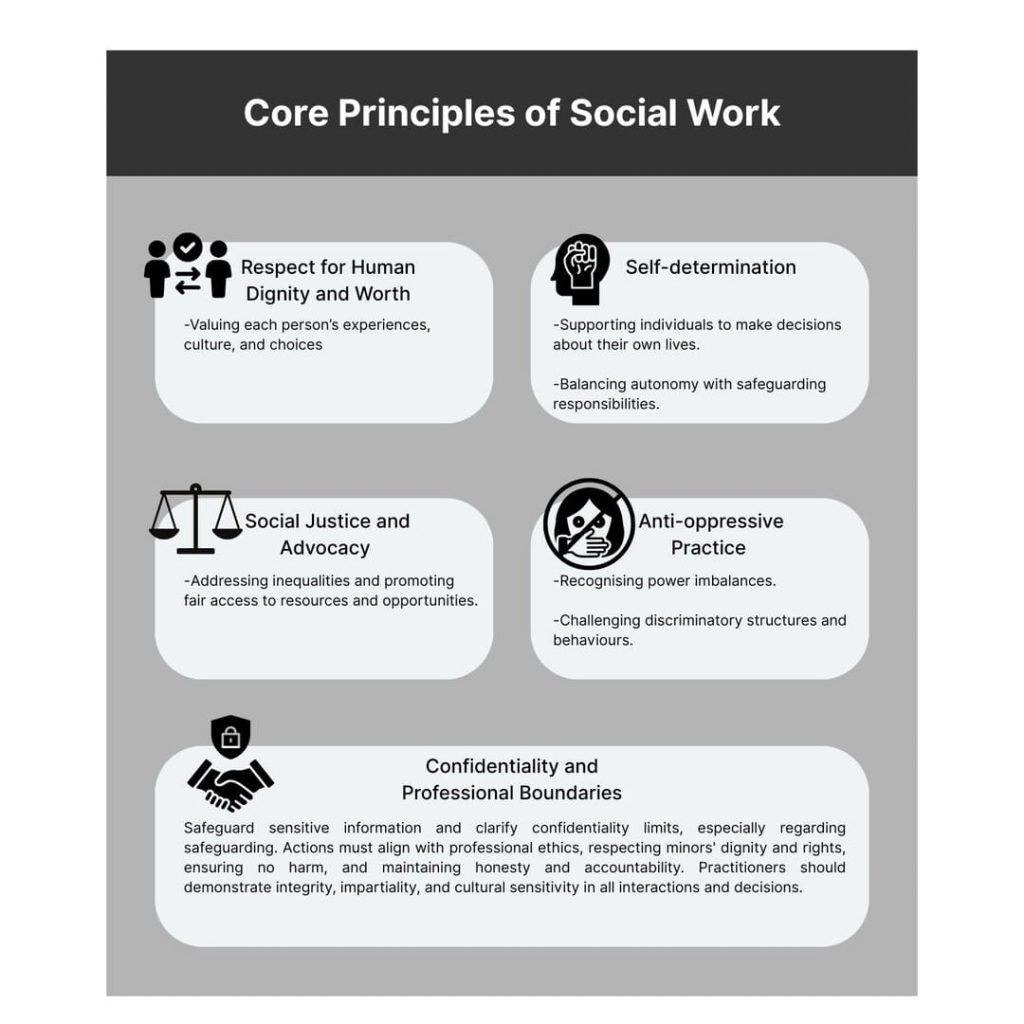
Applying Principles in Practice
Scenario Example: Supporting a Young Person at Risk of Exclusion
- Youth Work Lens
- Create a voluntary mentoring relationship.
- Use informal learning activities (e.g., group projects, art) to rebuild confidence.
- Empower the young person to explore their strengths and aspirations.
- Advocate within the school system to ensure their voice is heard.
- Social Work Lens:
- Complete a holistic assessment considering family, friendships, potential support network in general, health and education.
- Ensure rights are upheld (e.g., access to appropriate educational provision).
- Address systemic barriers (poverty, discrimination) affecting participation.
- Safeguard wellbeing while promoting self-determination.
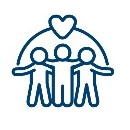
Integrating Both Approaches
Practitioners often blend principles to provide coordinated, person-centred support that is both empowering and protective. Applying youth work and social work principles in practice is not a one-size-fits-all approach. It requires flexibility, critical reflection, and commitment to empowering individuals and challenging injustice. By grounding our work in these core values, we create safe spaces where young people and communities can thrive.
Theory and approach for Mapping and IDP
Reflection and Development for Professionals working with a target group
Practitioners must:
- Reflect on their own values, biases, and power.
- Engage in continuous learning to adapt to diverse needs.
- Seek supervision to uphold ethical standards and professional accountability.
Prevention as an approach
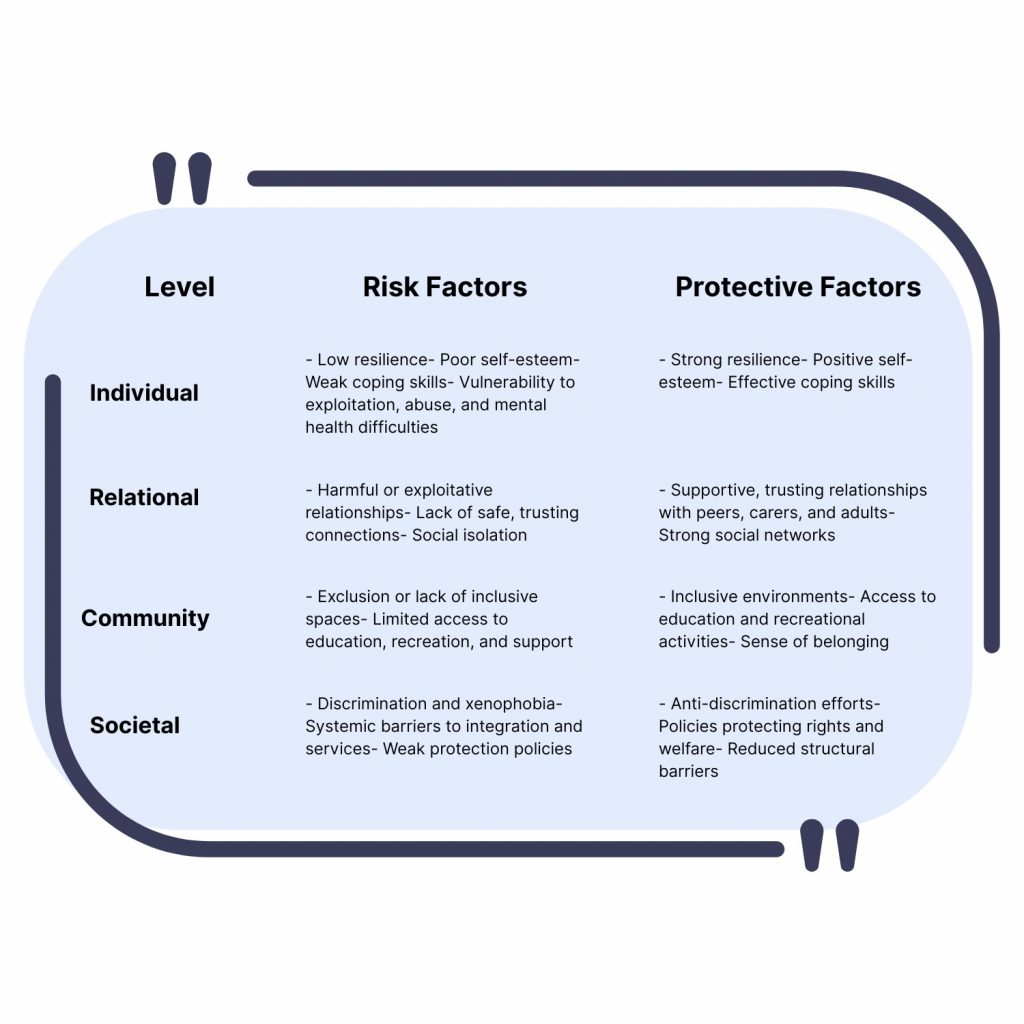
Prevention will address all types of negative influences on the target group, including factors at the individual, relational, community, and societal levels.

At the individual level, prevention focuses on strengthening young people’s resilience, self-esteem, and coping skills to reduce vulnerability to exploitation, abuse, and mental health difficulties.

At the relationship level, efforts will promote the development of safe, trusting connections with peers, carers, and supportive adults, while identifying and mitigating risks associated with harmful relationships and isolation.
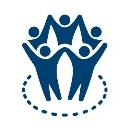
At the community level, prevention involves creating inclusive environments and access to education, recreational activities, and local resources that foster belonging, stability, and positive engagement.

At the societal level, prevention aims to challenge discrimination, reduce systemic barriers, and advocate for policies that protect the rights and welfare of unaccompanied refugee minors.
Together, these prevention strategies create a protective environment that reduces risk factors, strengthens protective factors, and supports young people’s healthy development and integration.
Intervention as an approach
Intervention
Social work intervention is the engagement a social worker has with an individual, family, group, or community that they are helping. In this case we would like to move away from one-size-fits-all approaches and to prioritize interventions that are personally and individually tailored to the needs of children on the move. An intervention plan (individual development plan) is formulated based on the person assessment to help ensure the best chance of success. Examples of intervention strategies include counseling, crisis intervention, community organisation, case management, advocacy, and active listening.
Holistic approach
A holistic approach involves examining all social factors of a person’s life, rather than focusing on one issue. With a holistic approach, social workers can view all major facets of a client’s life to better determine underlying issues that may cause problems, emotional distress or negative changes in behavior. With a strong understanding of why a person behaves a certain way, social workers can formulate an effective plan to help their client overcome challenges. When it comes to analyzing an individual holistically, there are a variety of methods to choose from. We are going to use ecological perspective theory.
Ecological perspective theory
Learning more about the events that shaped the individual’s personality and circumstances is essential to addressing the issues they’re dealing with. The ecological systems theory—also known as human ecology theory or development in context—examines how individuals’ environments shape them into who they are. The ecological perspective theory considers specific social factors of a person’s life to determine the reasoning behind their behavior. As applied to social work, the ecological perspective theory approaches behavior by examining the environmental and societal processes influencing a person; their reactions to changes in their surroundings; and the transformation of their overall health, behavior and attitude.
Mapping
Mapping (Assessment)
Complete an assessment (collecting information) to help understand the situation affecting the service user. Interpreting the data, this can offer the client or referrer an alternative way of viewing the problem. Construct an individual development plan collaboratively.
A comprehensive evaluation to understand each minor’s needs, vulnerabilities, strengths, and circumstances using a holistic, ecological approach.
Areas of Focus:
- Basic Demographics: Age, gender, cultural identity, legal status, reasons for leaving and journey taken.
- Health and Mental Health: Medical needs,physical and psychological well-being, trauma history.
- Education and Skills: Mother tongue/knowledge of other languages, education level/academic background, learning needs, vocational interests.
- Family and Social Relationships: Attachments, peer connections, loss and separation.
- Identity and Belonging: Cultural ties, sense of self, social inclusion.
- Environmental and Community Factors: Housing, economic stability, safety risks.
- Legal Considerations: Asylum process, guardianship, protective measures.
Mapping is collaborative—it combines the minor’s voice, professional observations, and contributions from relevant stakeholders.
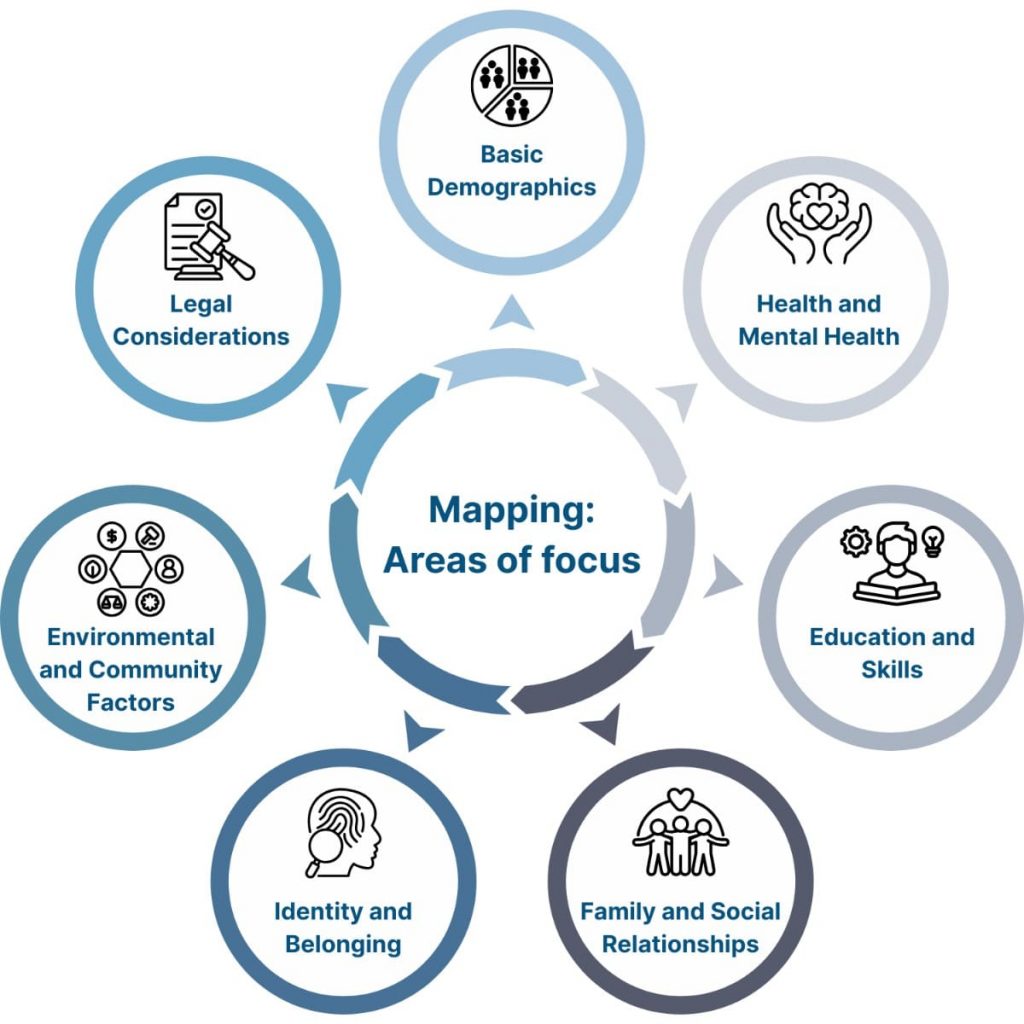
Belonging and Integration
Belonging is a fundamental human need. Participation in social and cultural activities fosters trust, self-esteem, and mutual understanding. Early relationships are critical for developing language skills, embracing shared values, and forming connections with peers and authorities. Trust and belonging arise from everyday social relationships. The absence of such connections can lead to exclusion or segregation, contributing to loneliness, mental health issues, and passivity. For children and youth, building relationships early is essential for feeling part of a community. Participation in various social and cultural arenas helps immigrants experience belonging and develop language skills. It is a prerequisite for immigrants to embrace shared societal values and trust other people and authorities.
The integrated approach to mapping and IDP creation ensures that unaccompanied refugee minors are supported in a holistic, dignified, and empowering manner. Through collaboration, tailored interventions, and a focus on belonging and participation, we can help them build safe, fulfilling lives in their new communities.
- How do my social and cultural activities contribute to my sense of belonging and trust within my community, and what steps can I take to enhance these connections?
- In what ways can I support unaccompanied refugee minors in building relationships and feeling integrated into our community, and how can I ensure that my actions promote their dignity and empowerment?
Individual Development Plan (IDP)
A personalized roadmap outlining goals, resources, and actions to support the minor’s growth and integration. An Individual Development Plan (IDP) is a personalized tool used to outline an individual’s goals and the steps required to achieve them. It is often used in career development and professional growth contexts, helping individuals plan their future, track their progress, and align their personal aspirations with their organization’s goals or broader career objectives.
- Vision and Aspirations: What the minor hopes to achieve.
- Goals: Clearly defined short-term and long-term objectives.
- Current Skill Assessment: Strengths and areas for development.
- Development Activities: Education, life skills training, counseling, and vocational pathways.
- Timelines and Milestones: Structured timeframe to track progress.
- Support and Resources: Mentors, services, and community assets.
- Monitoring and Review: Regular evaluation and adaptation of the plan.
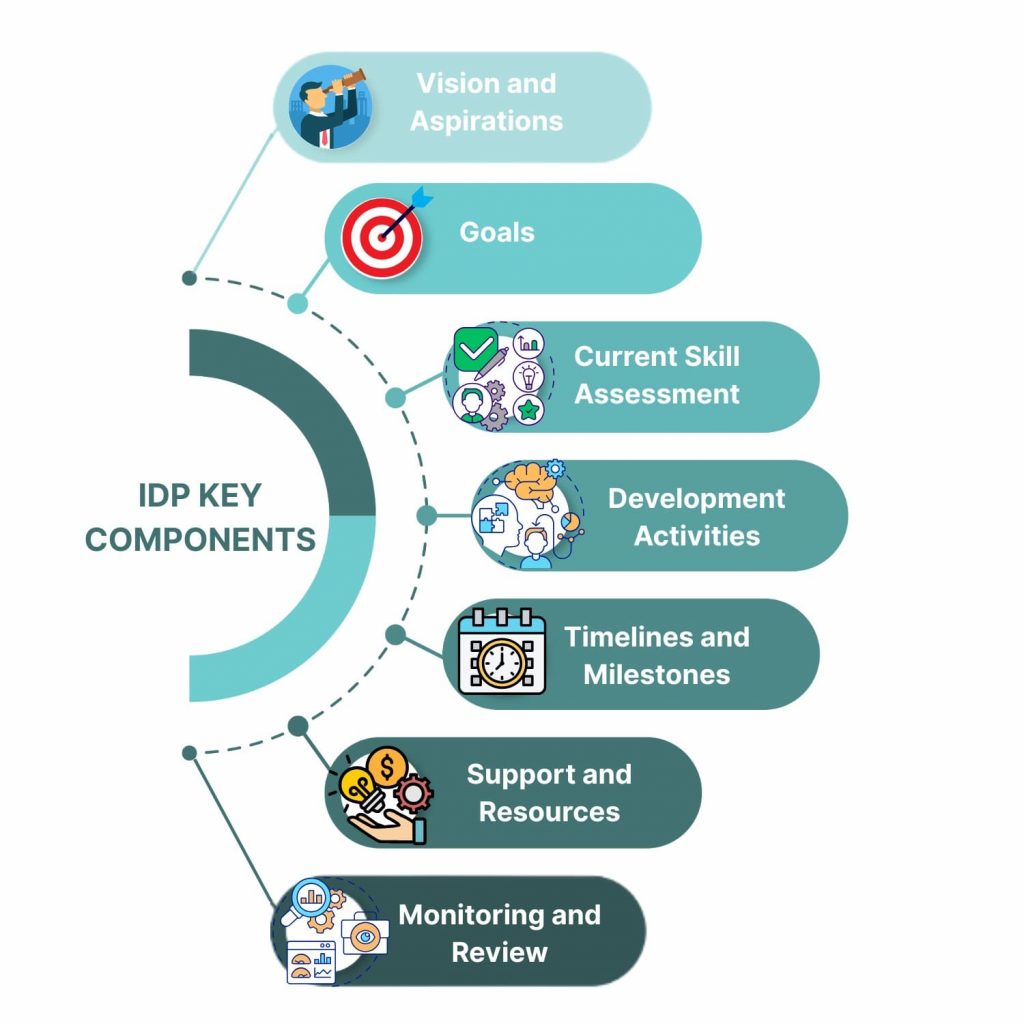
Steps for IDP implementation
1. Assessment and Identification

Initial Assessment: Upon arrival or identification, conduct a comprehensive assessment of the minor’s immediate needs, including physical health, mental health, safety, and basic necessities like food, clothing, and shelter.

Legal Status and Documentation: Ensure the child’s legal status is documented and they are registered with the relevant authorities. Facilitate access to asylum processes or other legal protections.
Multidisciplinary age assessment of migrant children
Many migrant/refugee children arrive in the EU without documentation, and their identity and age are often unclear. If there are doubts about a person’s age, authorities may conduct an “age assessment,” a process to establish whether the individual is a child. It is crucial to quickly identify unaccompanied or separated children among adults. Delays in identification can result in inadequate reception, lack of necessary support, or even administrative detention together with adults, or being exposed to the risks of trafficking, crime, and exploitation. Being established as soon as possible as a minor of age will open access to rights and guarantees that are specific for children in the context of the asylum procedure. It is also important that age assessment procedures be carried out in a way that is respectful of the rights of the person and reliable in terms of the results. With the adoption of the EU Pact on Asylum and Migration in May 2024, the EU introduced for the first time common rules on the age assessment procedures carried out in the context of asylum procedures. The Asylum Procedures Directive (2013/32/EU) provided only limited guidance on age assessment, and more specifically, only contained rules and specific procedural guarantees in relation to the use of medical methods of examination. The EUAA has provided guidance on age assessment, yet age assessment practices in the Member States have remained diverse. Few Member States have applied so far the multi-disciplinary age assessment methodology that is mandatorily required under Article 25 of the Asylum Procedures Regulation (2024/1348) and therefore the knowledge and experience built so far on the application of this method is still limited.
- Vulnerability Assessment: Evaluate the level of risk the child is exposed to, considering factors such as age, gender, past trauma, and current living conditions.
2. Immediate Protection Measures

Safe Accommodation : Make sure that all the procedures were followed so that the minor will have access to a safe, child-friendly environment, such as a foster family, group home, or specialized shelter for unaccompanied minors. Ensure the setting is equipped to meet their specific needs.

Health and Mental Health Services : Arrange for immediate medical and psychological evaluations. Provide ongoing access to healthcare, including trauma-informed mental health services.

Guardian Assignment: Arrange for appointment of the legal guardian or advocate who will act in the best interests of the child, ensuring they have someone responsible for their care and legal representation.
3. Psycho-Social Support

Counseling and Trauma Support: Offer individual and group counseling services to address trauma, loss, and the stress of displacement. Utilize culturally and linguistically appropriate approaches. For example cultural mediator.

Peer Support Groups: Facilitate peer support groups where unaccompanied minors can connect with others in similar situations, reducing isolation and building a sense of community.

Family Tracing and Reunification: Work with international organizations to trace family members and, if possible and in the best interest of the child, facilitate family reunification.
4. Education and Skill Development

Access to Education: Ensure immediate and continued access to education. This includes formal schooling as well as non-formal education that might address gaps due to interrupted education.

Language Learning: Provide access to language courses to help minors integrate into their new environment and participate fully in society.

Life Skills Training: Offer training in life skills, including basic financial literacy, self-care, and social integration skills. This is particularly crucial for older minors approaching adulthood.
5. Legal and Advocacy Support

Legal Aid Services: Provide access to legal aid to help navigate the asylum process, understand their rights, and ensure protection under international law. Support should not be limited to asylum application processes and procedures but should also help minors navigate the broader bureaucratic complexities they encounter in the new country.

Advocacy and Human Rights Education: Advocate on behalf of the minors in local and international forums to ensure their rights are protected and their voices are heard in decision-making processes affecting their lives. Educate minors on their rights and how to access available services and protection mechanisms.
6. Long-Term Integration and Support

Community Integration: Facilitate integration into the local community through mentoring programs, extracurricular activities, and community engagement initiatives.

Mentorship Programs: Connect minors with adult mentors who can provide guidance, support, and role modeling as they transition into adulthood. Additionally, facilitate connections with local peers to help build friendships, strengthen social networks, and promote a sense of belonging in the community.

Transition to Independence: For older minors, develop transition plans that prepare them for independent living, including vocational training, job placement services, and housing support.
7. Monitoring and Evaluation

Regular Monitoring: Continuously monitor the well-being of the minors, assessing their physical, emotional, and social health. Adjust care plans as needed.

Feedback Mechanisms: Establish channels for minors to provide feedback on the services they receive, ensuring their voices are heard in their own care.

Evaluation and Adaptation: Regularly evaluate the effectiveness of the protection measures and adapt the methodology based on feedback, changing circumstances, and evolving best practices.
8. Collaboration and Coordination
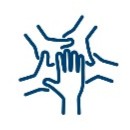
Multidisciplinary Teams: Establish multidisciplinary teams tailored to the individual case, as the composition of the team will depend on specific needs. For example, such teams may include social workers, legal professionals, healthcare providers, educators, psychologists, and cultural mediators.
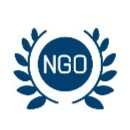
Partnerships with NGOs and International Organizations: Collaborate with NGOs/governmental services, UN agencies, and other stakeholders to ensure comprehensive care, leveraging resources and expertise.

Cross-Sector Coordination: Work with government agencies, law enforcement, and educational institutions to provide a seamless support system for minors.
Trauma-Informed Approach
Trauma-informed care is essential when working with unaccompanied minors who have often experienced war, violence, loss, and displacement.
A trauma-informed approach recognizes the prevalence and impact of trauma and prioritizes practices that:
- Promote safety—creating predictable, stable environments that avoid re-traumatization.
- Build trust—ensuring transparency, honesty, and consistency in all interactions.
- Empower choice and control—giving young people a voice in decisions affecting them.
- Support emotional regulation—using strategies to help manage overwhelming feelings.
- Respect cultural background—recognizing the role of culture in healing and resilience.
By integrating trauma-informed principles into assessment, planning, and intervention, professionals create a foundation for healing, resilience, and growth.
Participant Involvement
Active participation of the young person is at the heart of this approach. Involving minors in the assessment and planning process ensures that their experiences, preferences, and aspirations are respected and reflected in their Individual Development Plan. When young people have a meaningful voice in shaping their own goals and the steps to achieve them, they are more likely to feel empowered, motivated, and committed to their development journey. This participatory process also builds trust between the minor and professionals, enhances self-esteem, and promotes a sense of ownership and agency. Ultimately, participant involvement is essential not only for upholding the rights of the child but also for creating plans that are relevant, realistic, and more likely to succeed.
Referral networks and external collaboration
No single organisation can meet all the needs of a young refugee. Building and maintaining a network of trusted external services: healthcare providers, legal aid, vocational training, mental health support, recreational activities, and community organisations – is essential. Referrals should be made with the informed consent of the young person, who must be prepared and empowered for the process. Building and maintaining a trusted professional network is vital. Wherever possible, staff should aim to work with services they know and trust – where they are confident that the young person will be treated with dignity, professionalism, and care. The relationships we build with other providers reflect back on the young person’s experience; if they feel disrespected or neglected by a referred service, it may also damage their trust in us.
Confidentiality and consent are key when sharing information between services. Professionals must always:
- Share only relevant information, on a need-to-know basis;
- Obtain informed consent from the young person, unless there is a safeguarding concern;
- Explain clearly to the young person why the information is being shared and how it will help them.
In short, collaboration is not just about logistics – it’s about respect. Respect for the boundaries and contributions of other professionals, and most importantly, respect for the young person at the centre of it all.
Cross-Cultural Communication
Cross-cultural communication is a foundational principle when engaging with unaccompanied refugee minors whose identities, languages, and worldviews differ from the host country’s dominant culture. Effective cross-cultural communication:
✅ Acknowledges and respects cultural diversity
Recognizes the cultural beliefs, values, and traditions that shape young people’s identities and experiences.
✅ Reduces misunderstandings and barriers
Addresses potential language barriers, nonverbal cues, and cultural assumptions that can impact trust, participation, and service effectiveness.
✅ Fosters mutual understanding and trust
Promotes an environment where minors feel seen, heard, and respected, regardless of their background.
✅ Strengthens engagement and belonging
Supports young people in expressing their views, participating in decisions, and feeling included in their new communities.
Strategies for Cross-Cultural Communication:
- Use qualified interpreters or cultural mediators to facilitate clear communication and avoid misunderstandings.
- Engage in active listening, suspending judgment and clarifying meaning before responding.
- Be aware of cultural norms regarding eye contact, gestures, personal space, and emotional expression.
- Recognize power dynamics between professionals and minors that may affect openness or disclosure.
- Incorporate culturally relevant practices into assessment, planning, and interventions.
- Provide materials and information in languages minors understand to ensure comprehension of their rights and choices.
- Offer training for staff in cultural humility, anti-bias practice, and effective communication across cultures.
By integrating cross-cultural communication into all aspects of assessment, planning, and support, practitioners build trusting relationships that empower minors to participate fully in shaping their lives.
Effective Use of Translators and Interpreters
Working with unaccompanied refugee minors often requires the support of professional translators or interpreters to overcome language barriers and ensure clear, accurate communication. Proper use of translators is essential to respect the minor’s voice, build trust, and avoid misunderstandings.
Guidelines for Using Translators:
- Use Qualified and Neutral Professionals:
Always engage trained, impartial interpreters who understand confidentiality and the sensitive nature of the work. Avoid using family members, friends, or untrained individuals as this can compromise accuracy and privacy. - Brief the Interpreter in Advance:
Provide the translator with relevant background information (without breaching confidentiality) and explain the purpose of the session to help them prepare. - Explain the Role to the Minor:
Introduce the interpreter to the minor, explaining their role as a neutral language facilitator who will translate everything said during the conversation. - Speak Directly to the Minor:
Address the minor in the first person, maintaining eye contact and speaking in short, clear sentences. Avoid talking to the interpreter instead of the client. - Allow Time and Patience:
Remember that interpretation takes extra time. Speak slowly and pause frequently to allow for accurate translation. Encourage the minor to ask questions or request clarification. - Maintain Confidentiality and Professionalism:
Ensure that all parties understand the importance of confidentiality. The interpreter must adhere to ethical standards and keep all information private. - Be Culturally Sensitive:
Translators may also help bridge cultural gaps. Encourage them to provide context when necessary but avoid relying on them to make judgments or decisions. - Verify Understanding:
Periodically check that the minor understands the information being shared. Use simple language and ask the minor to repeat or summarize key points. - Document Language Needs:
Keep clear records of the minor’s preferred language and any accommodations made to support communication.
Using translators effectively is vital to empower unaccompanied minors, ensuring they fully participate in assessments, decision-making, and planning, and that their rights and needs are accurately understood and addressed.
IDP and Career Guidance
Individual Development Plan (IDP) (please take a look at the module 4 Career guidance to acquire more information about (IDP) in the context of career guidance) :
An Individual Development Plan (IDP) is a personalized, structured plan that helps a person—especially someone in a vulnerable situation—identify their:
✅ Current situation and needs
✅ Strengths and goals
✅ Barriers or challenges
✅ Concrete actions and support required
✅ Responsible persons or services
✅ Timeline and follow-up
Key components of an IDP
- Guides integration and stabilization (housing, health, legal status)
- Supports psychosocial wellbeing (emotional support, coping skills)
- Facilitates education and language learning
- Prepares for work or vocational training
- Strengthens social connections and independence
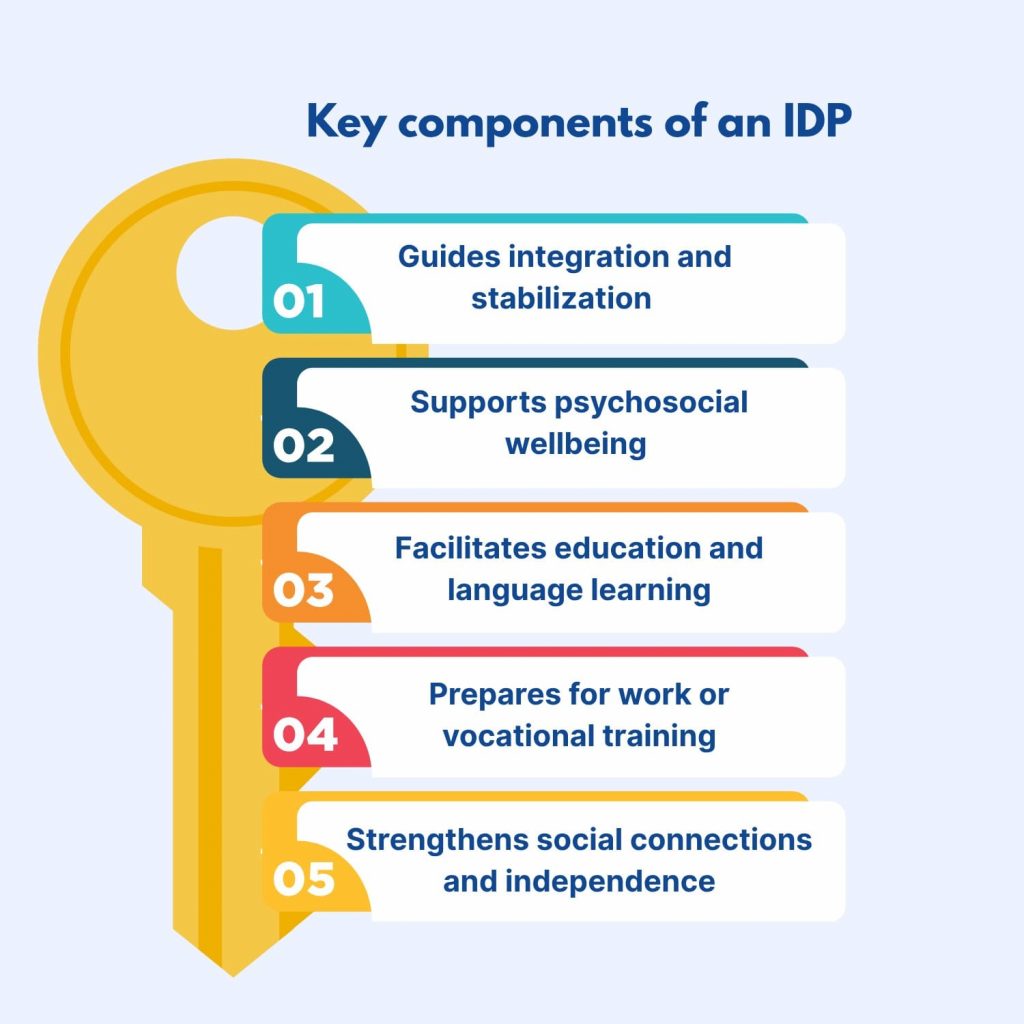
Career Goals: Clearly defined short-term and long-term career objectives. This can include desired job roles and education, skills to develop, and milestones to achieve.
Current Skill Assessment: An evaluation of the individual’s current skills, strengths, and areas for improvement. This helps in identifying gaps between the present state and the desired future state.
Development Activities: Specific actions or activities designed to help the individual acquire the necessary skills and experience. This can include training programs, mentorship, on-the-job experiences, or further education.
Timeline: A schedule outlining when the individual aims to achieve specific milestones. This helps in maintaining momentum and ensuring that progress is made systematically.
Support and Resources: Identification of the resources, such as mentors, training programs, or financial support, that will assist in achieving the development plan.
Monitoring and Review: A system for regularly reviewing progress against the plan. This can involve feedback from supervisors, self-assessment, or periodic formal reviews.
In short:
An IDP is like a roadmap to help a young person move step by step toward safety, belonging, and self-reliance, with the support of professionals.
Case Study
Ibrahim is a 20-year-old refugee who recently arrived in a new country. Due to conflict and displacement, Ibrahim was unable to complete his secondary education. He speaks his native language fluently and has limited English skills. He is highly motivated, has a strong work ethic, and wants to become financially independent while contributing to his new community. Ibrahim is interested in working with his hands — possibly in construction, logistics, or a trade like carpentry or auto repair. His goal is to build a stable career, starting with practical training and employment, and possibly returning to education in the future.
Take a look at the individual development plan (IDP) for Ibrahim. This example combines:
- Practical support (housing, health, legal orientation)
- Emotional support (counseling, community connection)
- Skills development (language, vocational training)
- Long-term integration planning.
Assignment: Look at the example(IDP for Ibrahim) and create an individual development plan (IDP) for Mohammad
Muhammad is a 17-year-old unaccompanied minor who arrived in the country six months ago after fleeing armed conflict. He lost contact with his family during the journey and has not heard from them since. Since his arrival, he has been living in a group accommodation facility for young refugees.
Muhammad speaks his native language fluently and has picked up some basic communication skills in the local language, but he still struggles with more complex interactions. He is shy and often withdrawn, preferring to spend time alone. Staff have observed that he avoids group activities and is hesitant to open up to adults.
However, Muhammad has shown some clear interests. He loves football and regularly plays alone or watches matches. He has expressed a desire to return to school, though he lacks documentation of his previous education. Additionally, Muhammad has recently mentioned that he would like to eventually have a part-time job so he can earn some money, gain independence, and help support his siblings if he’s ever able to reconnect with them. He is particularly interested in working with animals or doing something physically active, like gardening, delivery services, or working in a warehouse.
Muhammad struggles with stress, poor sleep, and recurring thoughts about his missing family. These emotional challenges affect his concentration and motivation. He currently has no family or support network in the new country, and he doesn’t fully understand the asylum process or how to plan for his future.
Risks of Unintentionally Causing Further Harm Without Proper Training
Working with unaccompanied refugee minors requires specialized skills and knowledge. Without adequate training in trauma-informed care, cultural sensitivity, and child protection, professionals risk unintentionally causing further harm to already vulnerable young people.
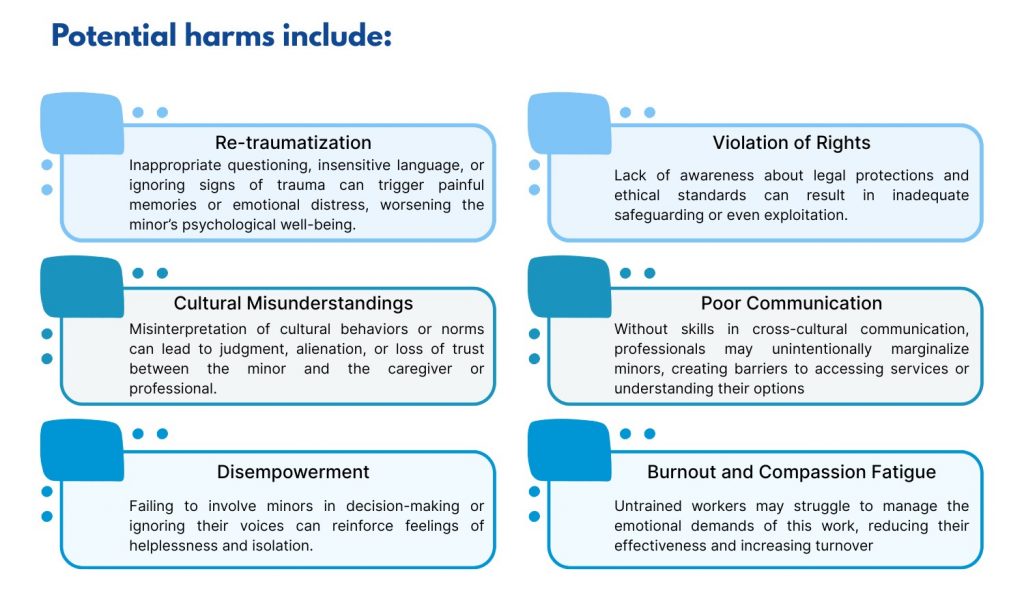
Mitigating these risks requires:

Comprehensive, ongoing training for all staff on trauma-informed approaches, cultural competence, child protection, and legal frameworks.

Supervision and reflective practice to help professionals process challenges and improve their skills.

Creating safe, supportive environments where minors feel respected and empowered to share their experiences at their own pace.

Collaboration with multidisciplinary teams to provide well-rounded, informed care.
Recognizing the complexities and vulnerabilities of unaccompanied minors, properly trained professionals are essential to ensuring interventions are safe, respectful, and effective, fostering healing and positive development rather than harm.
References & Further Reading
Mental Health and Psychosocial Support (MHPSS) Collaborative
https://app.mhpss.net/resources/
Trauma Informed Care With Refugee and Immigrant Youth
https://www.youtube.com/watch?v=5zvGu-iBGPo
The Outcome Star™ (Triangle Consulting)
CPIMS+ (Child Protection Information Management System) – by UNICEF/UNHCR
Cloud-based case management software designed for youth and community services.
https://www.lamplightdb.co.uk/
A practical toolset including safety planning, goal setting, and interagency coordination.
https://resourcecentre.savethechildren.net/
Inter-Agency Case Management Guidelines – [The Alliance for Child Protection in Humanitarian Action]
General Youth Work and Social Work Frameworks:
- Council of Europe Youth Work Youth work – Youth
- Youth Work | European Youth Portal
- Access to high-quality social services – European Commission
- Homepage – European Commission
Unaccompanied Refugee Minors—Risk, Protection, and Holistic Care:
- UNHCR & UNICEF. (2014). Safe & Sound: What States Can Do to Ensure Respect for the Best Interests of Unaccompanied and Separated Children in Europe.
Safe & Sound: What States can do to ensure respect for the best interests of unaccompanied and separated children in Europe | Refworld - World Health Organization. (2008). World Report on Violence and Health.
https://www.who.int/violence_injury_prevention/violence/world_report/en/
Policy and Practice Guidance for Working with Young Refugees:
- Council of Europe. (2017). Recommendation CM/Rec(2017)4 of the Committee of Ministers to Member States on Youth Work. ES178210_Prems 010917 GBR 2598 CMRec(2016)7etExposeMotifs 8361 TXT A5 WEB 2.pdf
- Inter-agency Guiding Principles on Unaccompanied and Separated Children
- UNICEF-Global-Insight-Guiding-Principles-for-children-on-the-move-in-the-context-of-climate-change-2022.pdf
- Child-Protection-Strategy-2021.pdf
- Pact on Migration and Asylum – European Commission
- Directive – 2013/32 – EN – Asylum Procedures Directive – EUR-Lex
- EASO Practical Guide on Age Assessment: Second edition
